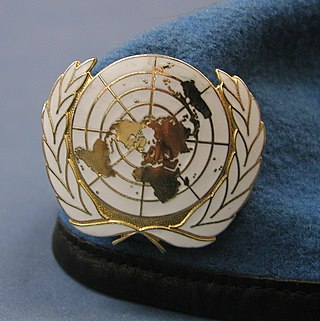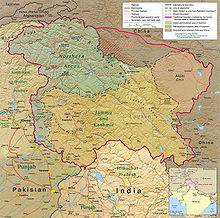
Azad Jammu and Kashmir, abbreviated as AJK and colloquially referred to as simply Azad Kashmir, is a region administered by Pakistan as a nominally self-governing entity and constituting the western portion of the larger Kashmir region, which has been the subject of a dispute between India and Pakistan since 1947. Azad Kashmir also shares borders with the Pakistani provinces of Punjab and Khyber Pakhtunkhwa to the south and west, respectively. On its eastern side, Azad Kashmir is separated from the Indian union territory of Jammu and Kashmir by the Line of Control (LoC), which serves as the de facto border between the Indian- and Pakistani-controlled parts of Kashmir. Geographically, it covers a total area of 13,297 km2 (5,134 sq mi) and has a total population of 4,045,366 as per the 2017 national census.

The history of Kashmir is intertwined with the history of the broader Indian subcontinent in South Asia with influences from the surrounding regions of Central, and East Asia. Historically, Kashmir referred to only the Kashmir Valley of the western Himalayas. Today, it denotes a larger area that includes the Indian-administered union territories of Jammu and Kashmir and Ladakh, the Pakistan-administered territories of Azad Kashmir and Gilgit-Baltistan, and the Chinese-administered regions of Aksai Chin and the Trans-Karakoram Tract.

The Indo-Pakistani war of 1947–1948, also known as the first Kashmir war, was a war fought between India and Pakistan over the princely state of Jammu and Kashmir from 1947 to 1948. It was the first of four Indo-Pakistani wars between the two newly independent nations. Pakistan precipitated the war a few weeks after its independence by launching tribal lashkar (militias) from Waziristan, in an effort to capture Kashmir and to preempt the possibility of its ruler joining India.
The Karachi Agreement of 1949 was signed by the military representatives of India and Pakistan, supervised by the United Nations Commission for India and Pakistan, establishing a cease-fire line in Kashmir following the Indo-Pakistani War of 1947. It established a cease-fire line which has been monitored by United Nations observers from the United Nations since then.

The Kashmir conflict is a territorial conflict over the Kashmir region, primarily between India and Pakistan, and also between China and India in the northeastern portion of the region. The conflict started after the partition of India in 1947 as both India and Pakistan claimed the entirety of the former princely state of Jammu and Kashmir. It is a dispute over the region that escalated into three wars between India and Pakistan and several other armed skirmishes. India controls approximately 55% of the land area of the region that includes Jammu, the Kashmir Valley, most of Ladakh, the Siachen Glacier, and 70% of its population; Pakistan controls approximately 30% of the land area that includes Azad Kashmir and Gilgit-Baltistan; and China controls the remaining 15% of the land area that includes the Aksai Chin region, the mostly uninhabited Trans-Karakoram Tract, and part of the Demchok sector.
The following is a timeline of the Kashmir conflict, a territorial conflict between India, Pakistan and, to a lesser degree, China. India and Pakistan have been involved in four wars and several border skirmishes over the issue.

In February 1948, the princely state of Junagadh, located in what is now the Indian state of Gujarat, was annexed to the Union of India after a dispute with the Dominion of Pakistan, regarding its accession, and a plebiscite.

The United Nations has played an advisory role in maintaining peace and order in the Kashmir region soon after the independence and partition of British India into the dominions of Pakistan and India in 1947, when a dispute erupted between the two new States on the question of accession over the princely state of Jammu and Kashmir. India took this matter to the UN Security Council, which passed resolution 39 (1948) and established the United Nations Commission for India and Pakistan (UNCIP) to investigate the issues and mediate between the two new countries. Following the cease-fire of hostilities, it also established the United Nations Military Observer Group in India and Pakistan (UNMOGIP) to monitor the cease-fire line.
United Nations Security Council Resolution 39, adopted on January 20, 1948, offered to assist in the peaceful resolution of the Kashmir Conflict by setting up a commission of three members; one to be chosen by India, one to be chosen by Pakistan and the third to be chosen by the other two members of the commission. The commission was to write a joint letter advising the Security Council on what course of action would be best to help further peace in the region.

United Nations Security Council Resolution 80, adopted on March 14, 1950, having received the reports of the Commission for India and Pakistan, as well as a report from General A. G. L. McNaughton, the Council commended India and Pakistan for their compliance with the ceasefire and for the demilitarization of Jammu and Kashmir and agreement on Fleet Admiral Chester W. Nimitz as the future Plebiscite Administrator.
United Nations Security Council Resolution 91, adopted on March 30, 1951, noting a report by Sir Owen Dixon, the United Nations Representative for India and Pakistan, stating that the main point of difference of preparing the state of Jammu and Kashmir for the holding of a plebiscite were as follows; the procedure for and extent of demilitarization, the degree of control over the exercise of the functions of government necessary to ensure a free and fair plebiscite.
United Nations Security Council Resolution 98, adopted on December 23, 1952, urged the Governments of India and Pakistan to enter into immediate negotiations under the auspices of the United Nations Representative for India and Pakistan in order to reach an agreement on the specific number of troops to remain of each side of the cease-fire line at the end of the previously established period of demilitarization. As proposed by the UN Representative this number was to be between 6000 Azad forces and 3500 Gilgit and northern scouts on the Pakistani side and 18000 Indian forces and 6000 local state forces on the Indian side. The resolution then thanked the UN Representative for his efforts, requested the Governments of India and Pakistan report to the Council no later than 30 days after the adoption of this resolution and asked the UN Representative to keep the Council informed of any progress.
Abdur Rasheed Turabi is a well-known politician of Azad Jammu & Kashmir. He was the Emir of Jamaat-e-Islami Azad Kashmir till July 2017. Dr Khalid Mahmood is his successor and newly elected Ameer of JI AJK. He is a well known columnist and also has written books giving the guidelines of solution of Kashmir dispute. He remained President of Islami-e-Jamiat Talaba Kashmir Chapter (1974–76). He participated greatly in the freedom movement of Kashmir. He is member of Legislative Assembly of Azad Jammu & Kashmir. He is also member of Muslim World league.

The Constituent Assembly of Jammu and Kashmir was a body of representatives elected in 1951 to formulate the constitution of Jammu and Kashmir. The Constituent Assembly was dissolved on 26 January 1957, based on Mir Qasim resolution it adopted and ratified on 17 November 1956.
The All Jammu and Kashmir Plebiscite Front, or Plebiscite Front, was a political party in the Indian state of Jammu and Kashmir that called for a "popular plebiscite" to decide if the state should remain part of India, join Pakistan or become independent. The patron of the party was Sheikh Abdullah, the former Prime Minister of Jammu and Kashmir and chief of the Jammu and Kashmir National Conference, even though he never formally joined it. The founder of the party was Mirza Afzal Beg.
Pakistan officially joined the United Nations (UN) on 30 September 1947 just over a month after it came into existence. Today, it is a charter member and participates in all of the UN's specialised agencies and organisations. Pakistan has been elected seven times into the UN Security Council, with the most recent term in 2013. It is also one of the countries which has had a diplomat, Muhammad Zafarullah Khan, serve a term as the President of the United Nations General Assembly.

The history of Azad Kashmir, a disputed part of the Kashmir region currently administered by Pakistan, is related to the history of the Kashmir region during the Dogra rule. Azad Kashmir borders the Pakistani provinces of Punjab and Khyber Pakhtunkhwa to the south and west respectively, Gilgit–Baltistan to the north, and the Indian union territory of Jammu and Kashmir to the east.The region is claimed by India as a part of the Jammu and Kashmir union territory and addressed as PoK( Pakistan-occupied Kashmir).

The Jinnah–Mountbatten Talks were bilateral talks held in Lahore between the Governor-Generals Muhammad Ali Jinnah and Louis Mountbatten of Pakistan and India, to address the Kashmir dispute. The talks were held on 1 November 1947, five days after India dispatched its troops to defend the princely state of Kashmir(which was a Muslim majority state recently acceded to India) against a tribal invasion. In the talks, Mountbatten presented India's offer to hold an impartial plebiscite under the United Nations auspices to decide the accession of Kashmir. Jinnah effectively rejected the offer.
The Azad Kashmir Regular Force (AKRF), formerly known as the Kashmir Liberation Forces(KLF), were the irregular forces of Azad Kashmir until 1948. They then were taken over by the government of Pakistan and converted into a regular force. In this form, the unit became part of the country's paramilitary forces, operating out of the nominally self-governing territory of Azad Jammu and Kashmir. The AKRF was altered from a functioning paramilitary force and merged into the Pakistan Army as an infantry regiment following the Indo-Pakistani War of 1971.
Karachi Agreement is an agreement purportedly executed on 28 April 1949 between the Government of Pakistan and the then Government of Azad Kashmir governing the relations between Pakistan and Azad Kashmir. It set down the division of the powers between the two governments as well as the All Jammu and Kashmir Muslim Conference. Through the agreement, Azad Kashmir ceded to the Government of Pakistan complete control over Gilgit-Baltistan, and the control over subjects of defence, foreign affairs and communications in its area.










